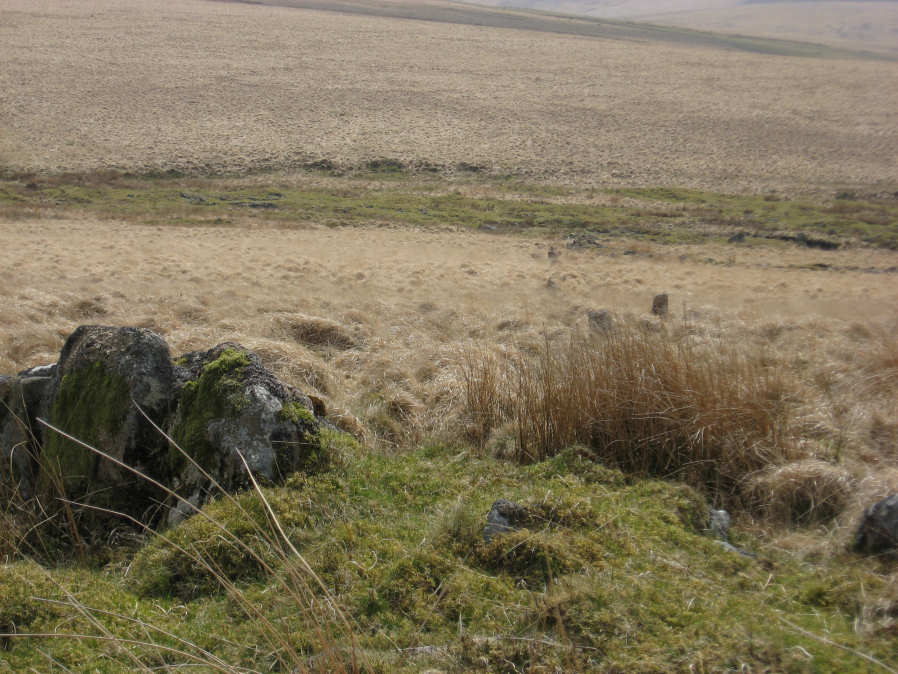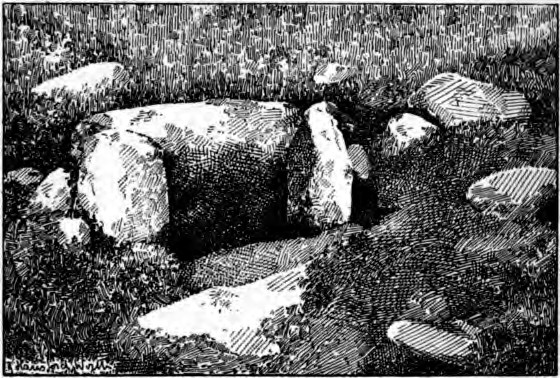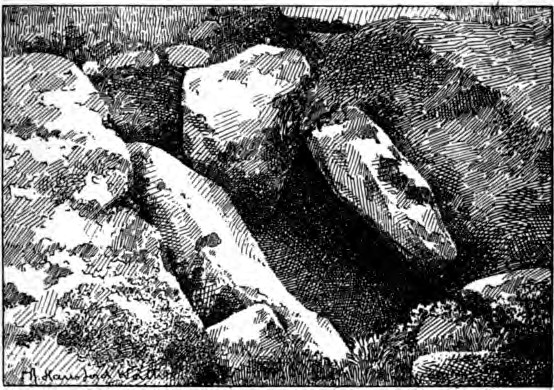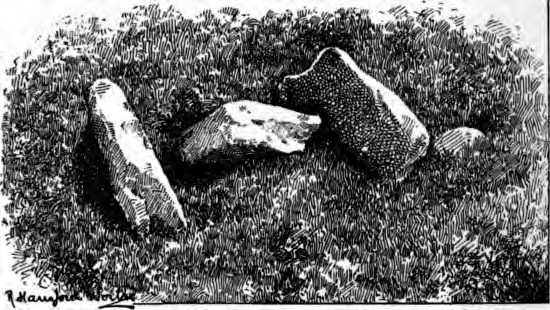
Dartmoor Site: The Hook Lake Stone Row on Brown Heath

Middle Bronze Age Round House (Left of photo) incorporating the Early Bronze Age Hook Lake stone row (Photo 02-05-2013)
Introduction Feb 2020
The author visited this site in 2013 and the photos and notes at the time put to one side to be processed later! They have now shown up after an audit in Feb 2020 of the materials in the author's archive and this material is of considerable interest. This article may well be revised if and when I get to return to Hook Lake.

Diagram of the Hentor & Shavercombe Brook Cists
I went for a long walk on south Dartmoor today. My mission was to take a look at the Hook Lake (Brown Heath) stone row - which is near the Erme Rings enclosures near Erme Pound.
I got a train to Ivybridge and walked up the east side of the River Erme passing the Butter Brook reservoir and Harford Gate. I ended up on the old Redlake rail track path and forked off across rough terrain towards where the Hook Lake (stream) meets the river Erme. From a distance you can see the Erme Rings - the series of large enclosures near Hook Lake.
It is a curious place - a rich palimpsest as the archaeologists would say [translating into English: a rich mix of features from different historic periods]. The first thing that struck me was the area around the Hook Lake stream marked as Stony Bottom on the map - it has the unmistakeable appearance of a landscape created by tin streaming works (probably medieval or a bit later) as are the clearly man-made ridges north of the stream. Beyond these is the massive wall of the southern most of the Erme Rings.
From the eastern side of this first enclosure is the Hook Lake stone row. In itself quite a small and unremarkable stone row. I have taken some photos but I have not yet bothered to look at them as the stones are knee-height at most with most considerably smaller. The interesting thing about this row is that it merges into the wall of this enclosure. Then if you follow it along its length it physically touches a hut circle, with one of the stones of the row being incorporated into the hut circle. A short distance further is a cairn with a cist which is surrounded by a ring of stones, the cairn is more impressive than the row. This cairn is extremely close to the second of the Erme Ring enclosures - within 1 metre of the circuit wall which "only grudgingly avoids the terminal cairn" (Jeremy Butler in "Dartmoor Atlas of Antiquities Vol. 4").
Richard Nichols Worth (father of Richard Hansford Worth) commented on this in the first of his series "The Stone Rows of Dartmoor" in the "Transactions of the Devonshire Association" as far back as 1892 - he concluded "the wall of the pound, which we must assume is of a later date". He would not have known what we now know, namely, that the stone rows date from the late Neolithic and Early Bronze Age where as the settlements, pounds and hut circles are from much later in the Bronze Age. R.N. Worth's observation was quite remarkable for the time. So those constructing these enclosures and huts would have done so up to potentially a thousand years or more later - clearly they had a certain disregard for the older monuments from a presumably forgotten age yet they did leave them in tact, the stones may have been incorporated into other structures but the stones of the row were not robbed out.
Further North from the second enclosure is the huge and quite fascinating structure known as Erme Pound. Again we have the meeting of different ages. This time there are tinners' huts (medieval or much later) incorporated within the pound. Some of the internal walls look prehistoric except they are surprisingly rectangular which would suggest they were added by the tinners, others are the more typically rounded or curved walls of the prehistoric. Erme Pound itself is well known as being used as a "drift pound" much like Dunnabridge Pound. The drifts were organised efforts to impound stray cattle and livestock illegally grazing on the moor. The first record of the use of Dunnabrdge as a drift pound dates back to 1342.
Finally it was nice to hear cuckoos and I think I saw a merlin - I'm not positive about the identification but it was small and had a distinctive orange colour underneath.
Bibliography & references
Butler, J. Dartmoor Atlas of Antiquities: Vol. 3. - The South-West (Devon Books, 1994)
Butler, Jeremy, Dartmoor Atlas of Antiquities, vol.5: The Second Millennium B.C., (1997)
Grinsell, L.V., Dartmoor Barrows, Devon Archaeological Society Proceedings No. 36 (1978)
Lethbridge, W.D. Discover Prehistoric Dartmoor (Halsgrove, 2015)
Pettit, Paul, Prehistoric Dartmoor, (1974)
Worth, R.H. Worth's Dartmoor (David & Charles, 1971)
Worth, R.H. Nineteenth Report of the Barrow Committtee Report & Transactions of the Devonshire Association Vol. 32 (1900)
Worth, R.N. Twelfth Report of the Barrow Committtee Report & Transactions of the Devonshire Association Vol. 22 (1890)
External Links
Excavation of Deadman's Bottom Cairns & Cists
Extract from nineteenth report of the Barrow Committee
NINETEENTH REPORT OF THE BARROW COMMITTEE
Nineteenth Report of the Committee, consisting of Mr P. F. S. Amery, Rev. S, Baring-Gould, Dr. Brushfield, Mr. R. Burnard, Mr. Cecil M. Firth, Mr. J, Brooking Rowe, and Mr. R. Hansford Worth (Secretary), appointed to collect and record facts relating to Barrows in Devonshire, and to take steps, where possible, for their investigation.
Edited by R. H. Worth, Hon. Secretary (Read at Totnes, August, 1900.)
Your Committee's Report for the year 1899-1900 has reference to the examination of a number of previously-rifled kistvaens in the moorland valley of the Plym. In addition to the kistvaens now described there are others in the same valley which require examination, and would have been reported on but that an excessive rainfall during the spring and early summer of the present year delayed the work.
RIFLED KISTVAENS IN THE PLYM VALLEY, DARTMOOR
The moorland valley of the Plym is rich in evidences of prehistoric man. With slight reservation it may be said that no more is to be learnt from an archaeological survey of the whole of Dartmoor than from a thorough investigation of this restricted area.
Within the catchment may be found hill-forts, pounds, very numerous hut circles, at least one "sacred circle," single and double stone rows, menhirs, barrows of all sizes, from the great "Giant's Basin" at Drizzlecombe to mere mounds of 15 feet diameter and under, and kistvaens; while, regarding the last, there is no other equal area of Dartmoor which affords such frequent examples.
PLATE 1
PLATE 2
PLATE 3
A number of these kistvaens have been broken into at unknown dates, the kists dug out, and their contents dispersed. The only apparent motive assignable for this spoliation would be the search for treasure, since, as will be seen later, the depredators in many cases ignored such relics as had no intrinsic value.
Did these treasure-hunts produce any valuable results? For obvious reasons it was the policy of the excavators to abstain from spreading abroad reports of their proceedings, and local tradition is entirely silent on the matter.
The consistent manner in which every discoverable kist or barrow has been ransacked would seem to suggest that occasional profit must have been derived from the proceeding, but this argument fails to be conclusive when it is remembered that there is no evidence confining the barrow-opening to any one period.
Generation after generation may have taken part in the search, individuals may have been discouraged, and abandoned it for more profitable occupations; but the lesson of their wasted labour would not necessarily deter their successors, even if known to them.
The question is unanswerable from insufficiency of data! The period at which the various barrows and kistvaens have been opened is equally obscure. It may seem a fair presumption that they remained undisturbed while any sanctity attached to them. The race that erected would probably not destroy until after the lapse of most considerable time. The amount of peat soil now to be found in many of the opened kists affords no real indication, for, although it would take long to accumulate, much of the spoil derived from excavation may have fallen back almost immediately after the search was abandoned.
Since there exists a licence to investigate certain barrows in Devon, granted in l324, [1] at least thus early the idea prevailed that treasure might be hidden therein.
Nine kistvaens have been thoroughly examined for the purposes of the present Report; of these, two only will be found marked in the Ordnance Survey. The following table, giving the number of the six-inch quarter-sheet on which each kistvaen should be marked, and the approximate latitude and longitude of each, will enable anyone who so wishes to indicate their positions with fair accuracy on the Ordnance sheets as now published.
[1] Eighth Report of Barrow Committee, Trans. Devon, Assoc, 1886.
TABLE GIVING APPROXIMATE LATITUDE AND LONGITUDE OF KISTVAENS.
| Distinguishing No. | Site. | No. of Quarter-sheet, 6" 0.S. | Longitude W. | Latitude N. |
|---|---|---|---|---|
| 1 | Wigford Down | CXII. S.E. | 4° 8' 4.5" | 50° 27' 39.5" |
| 2 | Guttor | CXII. S.E. | 4° 0' 16" | 50° 29' 0" |
| 3 | Lee Moor | CXII. S.E. | 3° 59' 50" | 50° 28' 12.5" |
| 4 | Drizzlecombe | CXII. S.E. | 3° 59' 15" | 50° 29' 0" |
| 5 | Drizzlecombe | CXII. N.E. | 3° 59' 8" | 50° 29' 13.5" |
| 6 | Langcombe, near Plym Steps | CXIII N.W. | 3° 58' 10" | 50° 29' 12" |
| 7 | Langcombe, near Deadman's Bottom | CXIII N.W. | 3° 57' 48" | 50° 29' 4" |
| 8 | Langcombe, near Deadman's Bottom | CXIII S.W. | 3° 57' 48" | 50° 29' 4" |
| 9 | Calveslake | CXIII N.W. | 3° 57' 41.5" | 50° 29' 26" |
The following errors in last year's Report have already appeared in Errata et Corrigenda appended to the Index of vol. xxxii. The corrections are here repeated for those who may have only reprints, or may bind reprints in one volume.
Page 52, line 10 (page 7 of reprint), "Nos. 8 and 9 and circles adjacent." This should be "Nos. 7 and 8 and circles adjacent." Throughout this section, as far as line 29 on page 53 (page 8 of reprint), "No. 8" or "8" should read "No. 7" or "7," and "No. 9" or "9" should read "No. 8" or "8" wherever referring to kistvaens.
Five kistvaens are described in the present Report; of these, two are marked on the six-inch Ordnance sheets. The following table gives the number of the six-inch quarter-sheet, on which each kistvaen should be marked, and the approximate latitude and longitude of each:
| Distinguishing No. | Site. | No. of Quarter-sheet, 6" 0.S. | Longitude W. | Latitude N. |
|---|---|---|---|---|
| 10 | Legis Tor | CX II. S.E. | 4° 0' 40" | 50° 28' 17" |
| 11 | Hentor | CXIII S.W. | 3° 58' 54" | 60° 28' 81" |
| 12 | Shavercombe | CXIII S.W. | 3° 58' 42" | 60° 28' 27.75 " |
| 13 | Great Gnat's Head | CXIII S.W. | 3° 57' 27.5" | 49° 29' 41.5" |
| 14 | Grim's Grave, Langcombe | CXIIL S.W. | 8° 57' 22" | 60° 28' 49.75" |
Table giving approximate latitude and longitude of kistvaens
Throughout the following descriptions all bearings have reference to true north. The order adopted is a progression from west, to east, starting, as in last year's Report, at the extreme western end of the valley.
Beading the two Reports together, the actual order in which the kistvaens occur is 1, 10, 2, 3, 4, 5, 11, 12, 6, 7, 8, 9, 13, 14.

10. Legis Tor (Plate XII.)
This kistvaen lies in a direction approximately 17 degrees south of east from the summit of Legis Tor and at a distance of 250 yards. The width between the side-stones at the north end is 1 foot 9 inches, and at the south end 3 feet 4.5 inches; but these measurements are taken from end to end of the stones and not at right angles to their direction. The eastern side-stone is 3 feet 1 inch in length and the western is 3 feet 4 inches long. No end-stones remain, and therefore the true length is unobtainable. The eastern side-stone is still firmly set, but the western has apparently been somewhat displaced.
To the south of the kist lies the cover-stone, of which the greatest length is 5 feet 4 inches, the greatest width 4 feet 2 inches.
Direction of length of eastern side-stone, 19 degrees west of north.
This kistvaen was opened when the Legis Tor hut circles were being examined in 1896, and gave no yield of either flint, pottery, ash, or charcoal.
Its chief peculiarity is that it has been built on an earth-fast boulder, the surface of which is some little distance below ground-level and forms a stone floor to the kist.
It was originally covered by a barrow, the present diameter of which is 16 feet

Plate 13 Hentor: VIEW. Looking 60° E of N
11. Hentor (Plate XIII.)

On the northern slope of Hentor, not far from the Shavercombe kistvaen (12), which is marked on Ordnance map. One side and both ends of this kistvaen still stand, and the cover-stone lies hard by. The south-eastern end-stone, which had partly fallen inwards, was re-erected after the kist had been excavated.
The dimensions of this kistvaen are: length, 2 feet 3 inches; breadth, 1 foot 4 inches at north-western end, 6.5 inches at south-eastern end, this last dimension being somewhat remarkable. In order to partly compensate for the extreme narrowness, it appears that the side-stone still standing has always leant towards the end-stones, and so given about 8 inches more width at the floor of the kist. The other side-stone may have been similarly set, but only one half of this remains, it having been broken along its length at some unknown date. The half remaining was buried in refilling the kistvaen. Direction of length, 63 degrees west of north. Result of excavation, the remains of a modern pocket-knife, apparently one lost by the author in 1889.
This kistvaen has been covered by a barrow, and apparently surrounded by a stone circle having a diameter of 11 feet.

Plate 14 Shavercombe: VIEW. Looking 28° E of S
12. Shavercombe (Plate XIV.)

Marked on Ordnance Survey. Two sides, one end-stone, and the cover-stone remain. The kist has been covered by a barrow, and lies in a stone circle of 10 feet 6 inches diameter.
The eastern side-stone had fallen against the western and completely closed the kist. This stone was, last year, turned back to admit of excavation, and has been left so.
Dimensions not properly ascertainable; length, probably 3 feet; breadth, at south end, probably 1 foot 6 inches; depth, which alone could be exactly ascertained, 2 feet 8 inches ; direction of length of kistvaen, 26 degrees west of north.
No results from excavation.

Plate 15 Great Gnats Head: VIEW. Looking 63° E of S
Page last updated 08/02/20